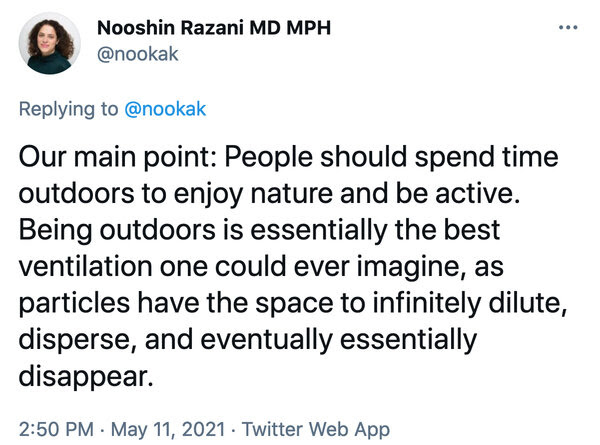We have the latest chapter on the C.D.C.’s description of outdoor Covid risks. |
|
The meaning of meta |
This morning, I am going to tell you another story about the C.D.C. and its approach to Covid-19 behavioral guidelines. It’s a story that highlights the costs of extreme caution. |
When Dr. Rochelle Walensky, the C.D.C. director, appeared before a Senate committee this month and defended the agency’s description of how often Covid-19 is transmitted outdoors, she cited a single academic study. |
She was responding to a question from Senator Susan Collins of Maine, who had asked why some C.D.C. guidelines seemed inconsistent with the available data. Collins quoted from that day’s edition of this newsletter and argued that the C.D.C. was exaggerating the risk of outdoor activities by claiming that “less than 10 percent” of Covid transmission occurred outside. |
Anything close to 10 percent would mean that outdoor infections were a huge problem. Yet the true share appears to be closer to 0.1 percent. |
Walensky replied that the 10 percent number came from a study published in The Journal of Infectious Diseases. The study was “a meta-analysis,” she explained, which means it synthesized data from other studies. “The topline result of all studies that were included in the systematic review said less than 10 percent of cases were transmitted outdoors,” she said. |
Her answer made the study sound definitive. Walensky did not mention any other studies or offer any logical argument for why she believed outdoor transmission was a significant risk. She implied that the C.D.C. was simply listening to The Journal of Infectious Diseases, which, as she noted, is a top journal. |
Later that day, one of the study’s authors posted several messages on Twitter, and the story got more complicated. |
‘An amazing resource’ |
The tweets came from Dr. Nooshin Razani, an epidemiologist at the University of California, San Francisco. In them, she emphasized that the study’s results suggested that the share of Covid occurring outdoors was “much lower than 10 percent.” The central message of the paper, Razani wrote, was the relative safety of the outdoors: |
|
This message seemed quite different from Walensky’s, so I followed up with a phone call to Razani. During it, she explained that the paper was not a meta-analysis, but rather a systematic review. (Walensky, in her testimony, had used the two terms interchangeably.) |
To nonscientists, the distinction may seem meaningless, but Razani thinks it is important. A meta-analysis often includes a precise estimate — a best guess, based on the data. A systematic review is more general. |
When Razani and her co-authors used the phrase “less than 10 percent” in the paper, they did not consider it to be an estimate, she told me. “We were very clear we were not making a summary number,” she said. |
It was instead a literal description of the other research. Most studies in the review found the share to be below 1 percent. But there was one study that somebody might interpret as suggesting the share of Covid transmission occurring outdoors was close to 10 percent. (In truth, many of those cases involved Singapore construction workers who probably transmitted it in enclosed spaces.) |
The actual share occurring outdoors is “probably substantially less than 1 percent,” Razani told me. “The outdoors is an amazing resource,” she added. “What we really should be focused on is how to transition more activities to be outdoors.” |
Masks for all campers |
Yet the C.D.C.’s guidance continues to treat outdoor activities as a major risk — as if the truth were closer to 10 percent than 0.1 percent. |
The agency advises unvaccinated people to wear masks outdoors much of the time, and many communities still impose strict guidelines on outdoor activities. The C.D.C. has also directed virtually everyone attending summer camp this year — counselor or camper, vaccinated or not — to wear a mask at almost all times. The camp guidelines use the word “universal.” |
It’s true that for many people, masks are a minor nuisance. For others, though, masks bring real costs. Some children find it harder to breathe while wearing one during, say, a game of soccer or tag. Many adults and children find it more difficult to communicate. That’s especially true for people without perfect hearing and for young children, both of whom rely heavily on facial movements to understand others. |
Communicating with a mask on, as Kathleen Pike, a Columbia University psychologist, has written, is often “like talking on your phone in a zone with weak cell service.” |
No free lunch |
For unvaccinated adults indoors or in close conversation outdoors, the costs of a mask are vastly lower than the risks from Covid. But the trade-offs are different in most outdoor settings, and they are different for children. The Covid risks for children are similar to those from a normal flu (as these charts show). |
There does not appear to be much scientific reason that campers and counselors, or most other people, should wear a mask outdoors all summer. Telling them to do so is an example of extreme caution — like staying out of the ocean to avoid sharks — that seems to have a greater cost than benefit. |
The C.D.C., as I’ve written before, is an agency full of dedicated people trying their best to keep Americans healthy. Walensky, a widely admired infectious-diseases expert, is one of them. Yet more than once during this pandemic, C.D.C. officials have acted as if extreme caution has no downsides. |
Everything has downsides. And it is the job of scientific experts and public-health officials to help the rest of us think clearly about the benefits and costs of our choices.
|






No comments:
Post a Comment